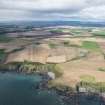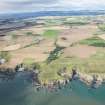Pricing Change
New pricing for orders of material from this site will come into place shortly. Charges for supply of digital images, digitisation on demand, prints and licensing will be altered.
Upcoming Maintenance
Please be advised that this website will undergo scheduled maintenance on the following dates:
Thursday, 9 January: 11:00 AM - 3:00 PM
Thursday, 23 January: 11:00 AM - 3:00 PM
Thursday, 30 January: 11:00 AM - 3:00 PM
During these times, some functionality such as image purchasing may be temporarily unavailable. We apologise for any inconvenience this may cause.
Kinneff, Kinneff Church
Burial Ground (Medieval), Church (18th Century), Churchyard (Medieval)
Site Name Kinneff, Kinneff Church
Classification Burial Ground (Medieval), Church (18th Century), Churchyard (Medieval)
Alternative Name(s) Kineff Old Parish Kirk
Canmore ID 36823
Site Number NO87SE 1
NGR NO 85542 74895
Datum OSGB36 - NGR
Permalink http://canmore.org.uk/site/36823
- Council Aberdeenshire
- Parish Kinneff
- Former Region Grampian
- Former District Kincardine And Deeside
- Former County Kincardineshire
NO87SE 1 85542 74895
NO87SE 1.01 85542 74895 Cross-slab
(NO 8553 7489) Although Kinneff parish church was rebuilt in 1738 (and repaired in 1784 and 1831, with some additions in 1876) its fabric incorporates considerable portions of an earlier building. It was dedicated to St Arnty or Arnold, probably corruptions of Adamnan, in 1242 (F C Eeles 1899). It belonged to the Priory of St Andrews.
About 1788, an earthen pot containing about 1 1/2 lbs of small silver coins of Edward of England and Alexander of Scotland (i.e. 13th- or 14th-century) was found while digging the grave of Lady Ogilvie of Barras (Statistical Account [OSA] 1793).
RCAHMS 1982; J C Watt 1914; A Jervise 1875; G Hay 1957; W Macfarlane 1906; I B Cowan 1967
Kinneff parish church is as described. Both church and graveyard are still in use.
Visited by OS (NKB) 21 December 1967
NMRS REFERENCE:
PLANS - F.A.M. MacDonald Collection
Walker and Duncan c. 1927 - 1 sheet survey plan.
Field Visit (March 1982)
Kinneff, Parish Church and Burial-ground NO 855 748 NO87SE 1 & 4
Although this church was rebuilt in 1738 its fabric incorporates considerable portions of an earlier building. It is on record in 1242, and about 1788 a 13th- or 14th-century coin hoard was found in the burial-ground. A cross-slab of Early Christian date (NMAS I B 174) found in the burial-ground in 1876, is believed to have come from the N wall of the church. Nothing remains of the 'old building', known as 'St Arnty's Kill', said to have been a 'religious house', which probably stood about 120m SW of the church; it was still visible in the 18th century (when it was referred to as 'St Arnold's bell'), but had been removed by 1842.
RCAHMS 1982, visited March 1982
(Stat. Acct., vi, 1793, 197, 209; NSA, xi, Kincardine, 314; Jervise 1875-9, i, 169-73; Eeles 1899; Macfarlane 1906-8, i, 257-9; Watt 1914, 131; Cowan 1967, 114)
Publication Account (1986)
An excellent example of a substantial T-plan Scottish kirk, it was largely rebuilt in 1738 and the north aisle added in 1876. The earlier church was most notable for having been the hiding place for the Honours of Scotland, the crown, sceptre and sword, that were smuggled out of Dunnottar Castle (no. 28) during Cromwell's seige of 1651. James Grainger, the minister, hid the crown and sceptre beneath a stone in front of the pulpit and the sword at the west end of the church; he and his wife dug up the Regalia at night once every three months in order to air them. Grainger's monument, with a suitably heroic inscription, is on the west wall. (There is also a memorial to the keeper of Dunnottar, George Ogilvie of Barras.)
Information from ‘Exploring Scotland’s Heritage: Grampian’, (1986).
Publication Account (1996)
An excellent example of a substantial T-plan Scottish kirk, it was largely rebuilt in 1738 and the north aisle added in 1876. The earlier church was most notable for having been the hiding place for the Honours of Scotland, the crown, sceptre and sword, that were smuggled out of Dunnottar Castle (no. 28) during Cromwell's seige of 165J. James Crainger, the minister, hid the crown and sceptre beneath a stone in front of the pulpit and the sword at the west end of the church; he and his wife dug up the Regalia at night once every three months in order to air them. Crainger's monument, with a suitably heroic inscription, is on the west wall. (There is also a memorial to the keeper of Dunnottar, Ceorge Ogilvie of Barras.)
Information from ‘Exploring Scotland’s Heritage: Aberdeen and North-East Scotland’, (1996).


















































